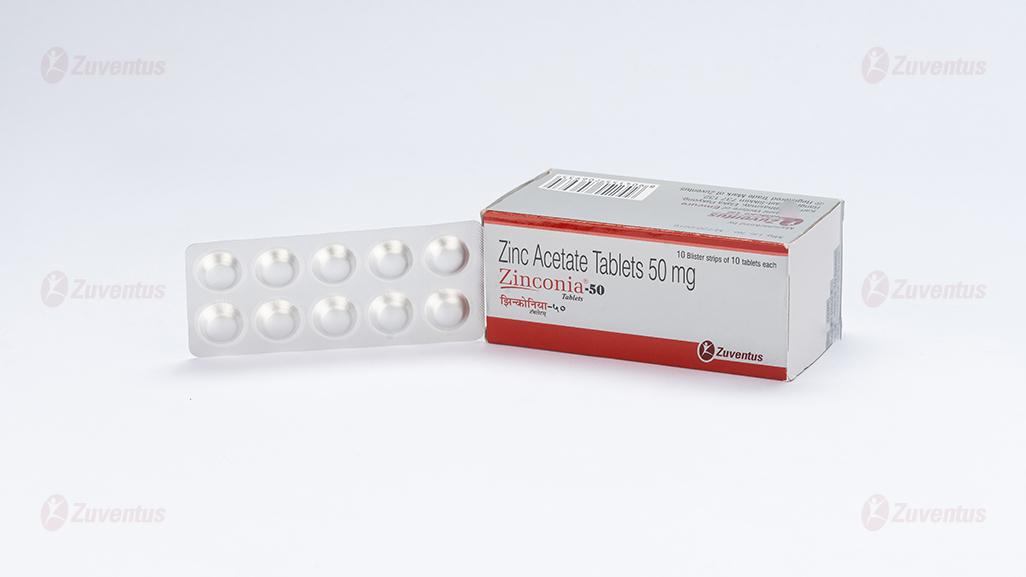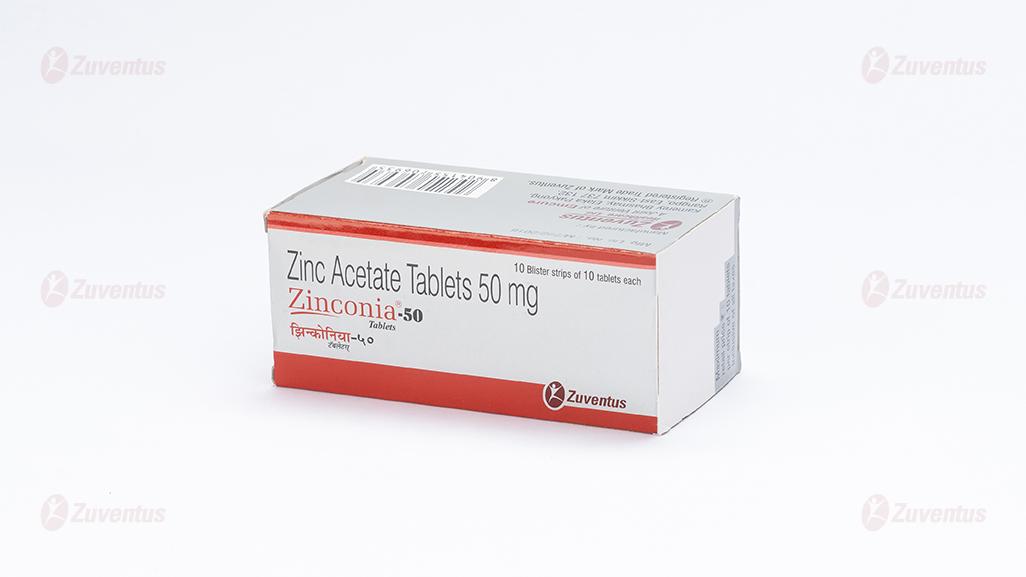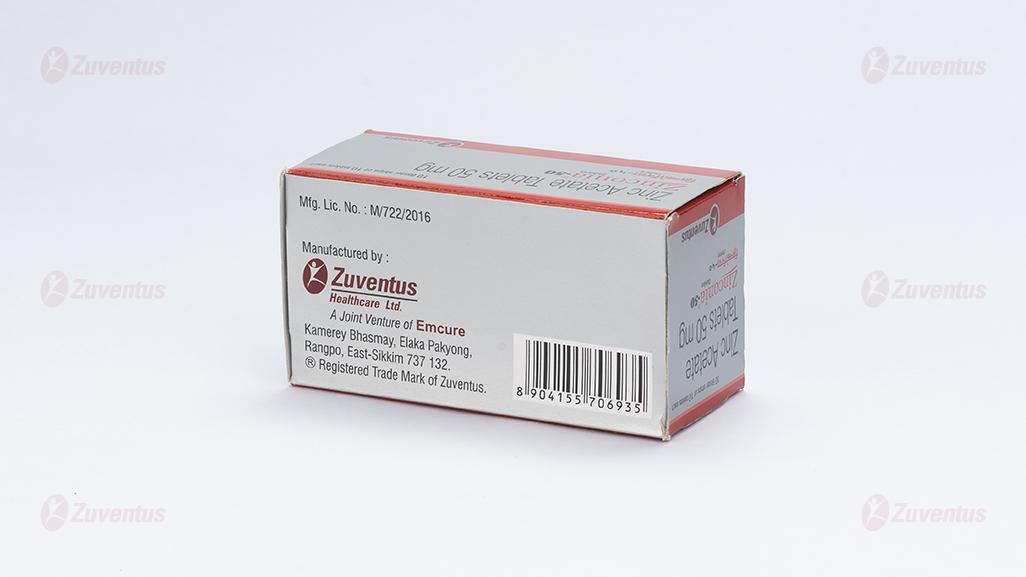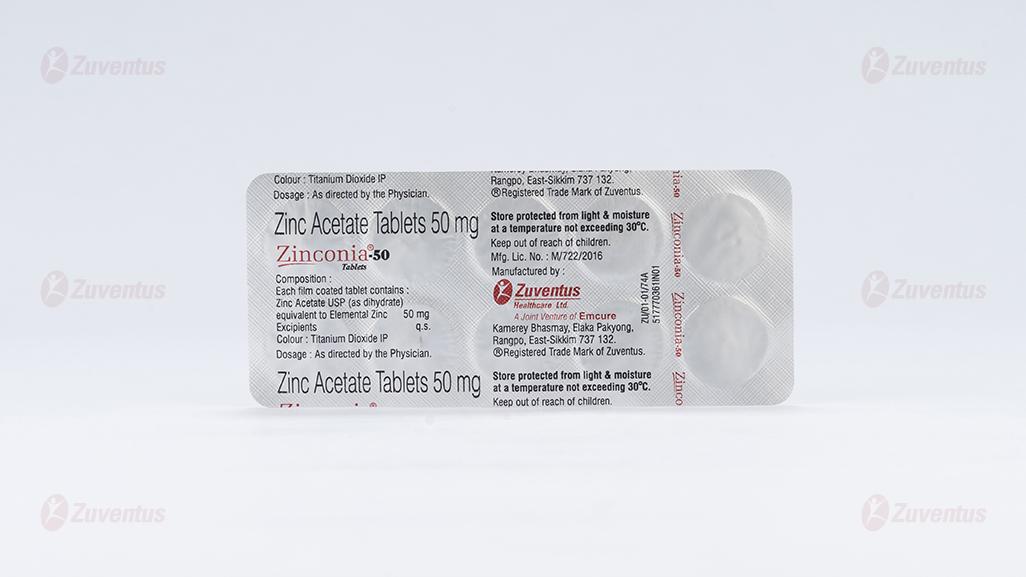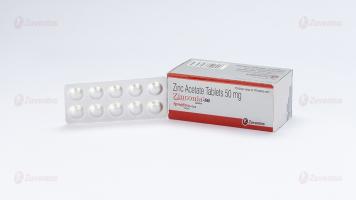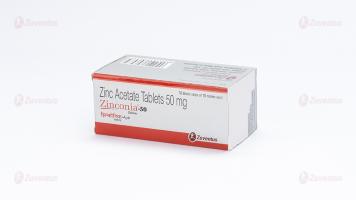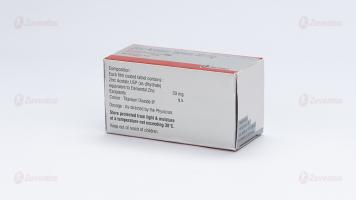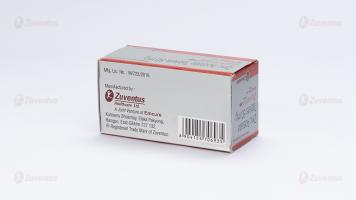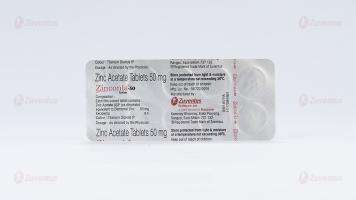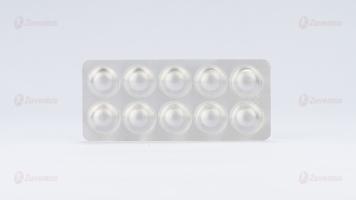Zinconia 50 Tablets
Therapy Area
Vitamins/Minerals Supplements
1.0 Generic name
Zinc Acetate Tablets 50 mg
2.0 Qualitative and quantitative composition
Each film coated tablet contains:
Zinc Acetate USP (as dihydrate) equivalent to Elemental Zinc 50 mg
Excipients q.s.
Colour: Titanium Dioxide I.P.
3.0 Dosage form and strength
Dosage Form: Tablet.
Dosage Strength: 50 mg per tablet
4.0 Clinical particulars
4.1 Therapeutic indication
Zinc sulfate is a source of zinc which is an essential trace element and involved in a number of body enzyme systems.
- ZINCONIA®-50 Tablets is indicated in adults and children for the treatment of zinc deficiency.
- Treatment of Wilson's disease.
4.2 Posology and method of administration
Method of Administration: Oral
Treatment of zinc deficiency.
Adults: One tablet, once to three times daily after meals.
Children:
- 30kg: One tablet, once to three times daily after meals.
- 10-30kg: ½ tablet, once to three times daily after meals.
Zinc should be taken between meals but if GI upset occurs, zinc can be taken with food.
Treatment of Wilson's disease.
ZINCONIA®-50 Tablets treatment should be initiated under the supervision of a physician experienced in the treatment of Wilson's disease. Zinc is a life-long therapy.There is no difference in dose between symptomatic and presymptomatic patients.
- Adults: The usual dose is 50 mg 3 times daily with a maximum dose of 50 mg 5 times daily.
- Children and adolescents:Data are very limited in children under 6 years but since the disease is fully penetrant, prophylactic treatment should be considered as early as possible. The recommended dosage is as follows:
- from 1 to 6 years: 25 mg twice daily
- from 6 to 16 years if bodyweight under 57 kg: 25 mg three times daily.
- from 16 years or if bodyweight above 57 kg: 50 mg three times daily.
• Pregnant women:
A dose of 25 mg 3 times daily is usually effective but the dose should be adjusted to copper levels.
In all cases, dose should be adjusted according to therapeutic monitoring.
ZINCONIA®-50 Tablets must be taken on an empty stomach, at least 1 hour before or 2-3 hours after meals. In case of gastric intolerance, often occurring with the morning dose, this dose may be delayed to mid-morning, between breakfast and lunch. It is also possible to take ZINCONIA®-50 Tablets with a little protein, such as meat.
When switching a patient on chelating treatment to ZINCONIA®-50 Tablets for maintenance therapy, the chelating treatment should be maintained and co-administered for 2 to 3 weeks since this is the time it takes for the zinc treatment to induce maximum metallothionein induction and full blockade of copper absorption. The administration of the chelating treatment and ZINCONIA®-50 Tablets should be separated by at least 1 hour.
4.3 Contraindications
- Hypersensitivity to the active substance or any of the excipients.
- Copper deficiency (see section 4.5).
4.4 Special warnings and precautions for use
Renal impairment: Accumulation of zinc may occur in cases of renal failure. Hence caution should be exercised in patients with renal impairment with careful patient monitoring
4.5 Drugs interactions
Copper: Zinc may inhibit the absorption of copper (see section 4.3).
Tetracycline Antibacterials: Zinc may reduce the absorption of concurrently administered tetracyclines, also the absorption of zinc may be reduced by tetracyclines; when both are being given an interval of at least three hours should be allowed.
Quinolone Antibacterials: Zinc may reduce the absorption of quinolones; ciprofloxacin, levofloxacin, moxifloxacin, norfloxacin and ofloxacin.
Calcium Salts: The absorption of zinc may be reduced by calcium salts.
Iron: The absorption of zinc may be reduced by oral iron, also the absorption of oral iron may be reduced by zinc.
Penicillamine: The absorption of zinc may be reduced by penicillamine, also the absorption of penicillamine may be reduced by zinc.
Trientine: The absorption of zinc may be reduced by trientine, also the absorption of trientine may be reduced by zinc.
4.6 Use in special populations
Pregnancy
The safety of this product in human pregnancy has not been established. Zinc crosses the placenta and is present in breast milk.
Lactation
Zinc is excreted in human breast milk and zinc-induced copper deficiency in the breast-fed baby may occur. Therefore, breast-feeding should be avoided during zinc therapy.
4.7 Effects on ability to drive and use machines
Zinconia®-50 Tablets has no influence on the ability to drive and use machines.
4.8 Undesirable effects
Zinc salts may cause abdominal pain, dyspepsia, nausea, vomiting, diarrhoea, gastric irritation and gastritis. There have also been cases of irritability, headache and lethargy observed. Zinc may interfere with the absorption of copper, leading to reduced copper levels, and potentially copper deficiency. The risk of copper deficiency may be greater with long-term treatment (e.g. if zinc deficiency is no longer present) and/or with higher doses of zinc.
Reporting of suspected adverse reactions
Reporting suspected adverse reactions after authorisation of the medicinal product is important. It allows continued monitoring of the benefit/risk balance of the medicinal product. Healthcare professionals are asked to report any suspected adverse reactions via email to: medico@zuventus.com
Website: https://www.zuventus.com/drug-safety-reporting
By reporting side effects, you can help provide more information on the safety of this medicine.
4.9 Overdose
Zinc Acetate is corrosive in overdosage. Symptoms are corrosion and inflammation of the mucous membrane of the mouth and stomach; ulceration of the stomach followed by perforation may occur. Gastric lavage and emesis should be avoided. Demulcents such as milk should be given. Chelating agents such as sodium calcium edetate may be useful
5.0 Pharmacological properties
5.1 Mechanism of Action
Zinc supplementation improves immunity. Various studies have quoted different mechanisms of action of zinc in persistent and infective diarrhea patients: Preclinical studies have shown that zinc inhibits cAMP induced, chloride dependent fluid secretion by inhibiting basolateral potassium (K) channels of ileal mucosa. Zinc also improves the absorption of water and electrolytes, improves regeneration of the intestinal epithelium, increases the levels of brush border enzymes, and enhances the immune response, allowing for a better clearance of the pathogens. Recent evidence demonstrate that zinc inhibits toxin induced cholera.
It is demonstrated that zinc supplementation could improve symptoms of acute respiratory illness. It may prevent premature cell destruction and promotes activity of enzymes that affect production of prostaglandin from essential fatty acids, and as a result, leads to decrement of inflammation in airways. It also can activate natural killer cells, macrophages and lymphocytes.
Zinc has critical effect in homeostasis, in immune function, oxidative stress, apoptosis, and aging, and significant disorders of great public health interest are associated with zinc deficiency. In many chronic diseases, including atherosclerosis, several malignancies, neurological disorders, autoimmune diseases, aging, age-related degenerative diseases, and Wilson's disease, the concurrent zinc deficiency may complicate the clinical features, affect adversely immunological status, increase oxidative stress, and lead to the generation of inflammatory cytokines. In these diseases, oxidative stress and chronic inflammation may play important causative roles.
5.2 Pharmacodynamic properties
Pharmacotherapeutic Group: Mineral Supplement, ATC Code: A12CB01
Zinc is an essential trace element involved in many enzyme systems. Severe deficiency causes skin lesion, alopecia, diarrhoea, increased susceptibility to infections and failure to thrive in children. Symptoms of less severe deficiency include distorted or absent perceptions of taste and smell and poor wound healing.
5.3 Pharmacokinetic properties
Zinc is absorbed from the gastrointestinal tract and distributed throughout the body. The highest concentrations occur in hair, eyes, male reproductive organs and bone. Lower levels are present in liver, kidney and muscle. In blood 80% is found in erythrocytes. Plasma zinc levels range from 70 to 110μg/dL and about 50% of this is loosely bound to albumin. About 7% is amino-acid bound and the rest is tightly bound to alpha 2-macroglobulins and other proteins.
6.0 Nonclinical properties
6.1 Animal Toxicology or Pharmacology
None stated.
7.0 Description
Zinc acetate as the dihydrate is a salt of zinc used for the treatment of acute diarrhoea in children as an adjunct to oral rehydration.
Zinc is an integral component of many metallo enzymes in the body; it is involved in the synthesis and stabilization of proteins, DNA and RNA, and plays a structural role in ribosomes and membranes. Zinc is involved in oxygen transport and protection against free radical damage. Zinc facilitates wound healing and helps maintain normal growth rates, normal skin hydration and senses of taste and smell. Zinc acts as an integral part of several enzymes important to protein and carbohydrate metabolism.

Zinc Acetate Dihydrate Structure
Molecular Formula: C4H6O4Zn.2H2O
Molecular Weight: 219.5 g/mol
8.0 Pharmaceutical particulars
8.1 Incompatibilities
Not applicable.
8.2 Shelf-life
Refer to pack.
8.3 Packaging information
10 Blister strips of 10 tablets each.
8.4 Storage and handing instructions
Store protected from light & moisture at a temperature not exceeding 30°C.
Keep out of reach of children.
9.0 Patient counselling information
Do not take Zinconia®-50 Tablets
- if you are allergic (hypersensitive) to zinc acetate or any of the other ingredients.
- if you have copper deficiency
Talk to your doctor, before taking Zinconia® -50 Tablets if you suffer from kidney disease. If this applies to you it is important that you tell your doctor or pharmacist before taking Zinconia®-50 Tablets and they will decide what to do.
Tell your doctor or pharmacist if you are taking, have recently taken or might take any other medicines. This is especially important if you are taking or have recently taken any of the following:
- Copper
- Tetracycline Antibacterials
- Quinolone Antibacterials
- Calcium Salts
- Iron
- Penicillamine
- Trientine
Zinconia®-50 Tablets should be taken after meals.
About leaflet
Read all of this leaflet carefully before your child starts using this medicine, because it contains important information for you.
- Keep this leaflet. You may need to read it again.
- If you have any further questions, please ask your child’s doctor, pharmacist or nurse.
- This medicine has been prescribed for your child only. Do not pass it on to others. It may harm them, even if their signs of illness are the same as your child’s.
- If your child gets any side effects, talk to your child’s doctor, pharmacist or nurse. This includes any possible side effects not listed in this leaflet. See section 4
What is in this leaflet
- What ZINCONIA®-50 Tablets is and what it is used for
- What you need to know before you use ZINCONIA®-50 Tablets
- How to use ZINCONIA®-50 Tablets
- Possible side effects How to store ZINCONIA®-50 Tablets
- Contents of the pack and other information
1. What ZINCONIA®-50 Tablets is and what it is used for
ZINCONIA®-50 Tablets is a is a mineral supplement used for the treatment and prevention of zinc deficiency states in adult patients. ZINCONIA®-50 Tablets contains zinc acetate (as dihydrate). Zinc acetate dihydrate is a source of zinc, which is an essential trace element and involved in a number of body enzyme functions.
Zinc is an essential trace element involved in many enzyme systems. Severe deficiency causes skin lesion, alopecia, diarrhoea, increased susceptibility to infections and failure to thrive in children. Symptoms of less severe deficiency include distorted or absent perceptions of taste and smell and poor wound healing.
ZINCONIA®-50 Tablets is also indicated in the treatment of Wilson’s disease, which is a rare inherited defect in copper excretion. Dietary copper, which cannot be properly eliminated, accumulates first in the liver, then in other organs such as the eyes and the brain. This potentially leads to liver damage and neurological disorders. ZINCONIA®-50 Tablets blocks the absorption of copper from the intestine thereby preventing its transfer into the blood and its further accumulation in the body. Unabsorbed copper is then eliminated in the stool. Wilson’s disease will persist during the entire lifetime of the patient and therefore the need for this treatment is life-long
You must talk to a doctor if you do not feel better or if you feel worse.
2. Before you take ZINCONIA®-50 Tablets
Do not take ZINCONIA®-50 Tablets if you
- if you are allergic (hypersensitive) to zinc sulfate monohydrate or any of the other ingredients of this medicine (listed in section 6).
- if you have copper deficiency
Talk to your doctor if this applies to you.
Warnings and precautions
- Talk to your doctor, pharmacist or nurse before taking ZINCONIA®-50 Tablets if you suffer from kidney disease.
- If this applies to you it is important that you tell your doctor or pharmacist before taking ZINCONIA®-50 Tablets and they will decide what to do. It may still be safe for you to take syrup.
Taking other medicines
Tell your doctor or pharmacist if you are taking, have recently taken or might take any other medicines.
This is especially important if you are taking or have recently taken any of the following:
- copper supplements (see section 2 “Do not take ZINCONIA® ….’)
- tetracycline antibiotics (such as oxytetracycline or doxycycline) used to treat certain bacterial infections
- quinolone antibiotics (such as ciprofloxacin, levofloxacin, moxifloxacin, norfloxacin and ofloxacin) used to treat certain bacterial infections
- calcium salt preparations
- iron preparations
- penicillamine (used to treat rheumatoid arthritis, Wilson’s disease, autoimmune hepatitis and cystinuria)
- trientine (used in the treatment of Wilson’s disease)
Please tell your doctor or pharmacist if you are taking or have recently taken any other medicines, including medicines obtained without a prescription.
Taking ZINCONIA®-50 Tablets with food and drink
You should take ZINCONIA®-50 Tablets after meals.
Pregnancy and breast-feeding
The safety of ZINCONIA®-50 Tablets in human pregnancy is not known. Zinc has been shown to cross the placenta and is present in breast milk in females taking zinc supplements. Only take this product during pregnancy or while breast-feeding if your doctor has advised you to do so.
Ask your doctor or pharmacist for advice before taking any medicine during pregnancy or while breast-feeding.
Driving and using machines
ZINCONIA®-50 Tablets is not expected to affect the ability to drive or use machine.
3. How to take ZINCONIA®-50 Tablets
Always take ZINCONIA®-50 Tablets exactly as your doctor has told you. It should be taken orally.
Dose for Zinc deficiency
Adults: One tablet, once to three times daily after meals.
Children: More than 30kg: One tablet, once to three times daily after meals.
10-30kg: ½ tablet, once to three times daily after meals.
Less than 10kg: ½ tablet, once daily after meals.
Dose for treatment of Wilson’s disease
For adults: The usual dose is 1 ZINCONIA®-50 Tablets three times daily with a maximum dose of five times daily.
- For children and adolescents: The usual dose is:
- from 1 to 6 years: 25 mg twice daily
- from 6 to 16 years if bodyweight under 57 kg: 25 mg three times daily
- from 16 years or if bodyweight above 57 kg: 1 ZINCONIA®-50 Tablets three times daily.
If you take more ZINCONIA®-50 Tablets than you should
If you take too large dosage, contact your nearest hospital casualty department or doctor
immediately. Take this leaflet and any remaining tablets with you to show the doctor.
If you forget to take ZINCONIA®-50 Tablets
If you forget to take your dose, take it as soon as you remember and then continue with the next dose as instructed. Do not take a double dose to make up for a forgotten dose.
If you have any further questions on the use of this product, ask your doctor or pharmacist.
If you stop taking ZINCONIA®-50 Tablets
To get the most benefit from ZINCONIA®-50 Tablets, always finish the course of treatment recommended by your doctor or pharmacist.
If you have any further questions on the use of this medicine, ask your doctor, pharmacist or nurse.
4. Possible side effects
Like all medicines, ZINCONIA®-50 Tablets can cause side effects, although not everybody gets them.
Side effects with ZINCONIA®-50 Tablets may include:
- reduced copper levels, potentially leading to copper deficiency
- abdominal pain
- indigestion
- nausea (feeling sick)
- vomiting (being sick)
- diarrhoea
- stomach discomfort
- irritability
- headache
- lethargy (a feeling of weariness)
Reporting of side effects
If you get any side effects, talk to your doctor. This includes any possible side effects not listed in this leaflet. You can also report side effects directly: Website: www.zuventus.com and click the tab “Drug Safety Reporting” located on the top of the home page.
By reporting side effects, you can help provide more information on the safety of this medicine.
5. How to store ZINCONIA®-50 Tablets
Store protected from light & moisture at a temperature not exceeding 30oC.
Keep out of reach of children.
6. Contents of the pack and other information
What ZINCONIA® -50 Tablets contains
Each film coated tablet contains:
Zinc Acetate USP (as dihydrate) equivalent to Elemental Zinc 50 mg
Excipients q.s.
Colour: Titanium Dioxide I.P.
What ZINCONIA®-50 Tablets looks like and contents of pack
10 Blister strips of 10 tablets each.

